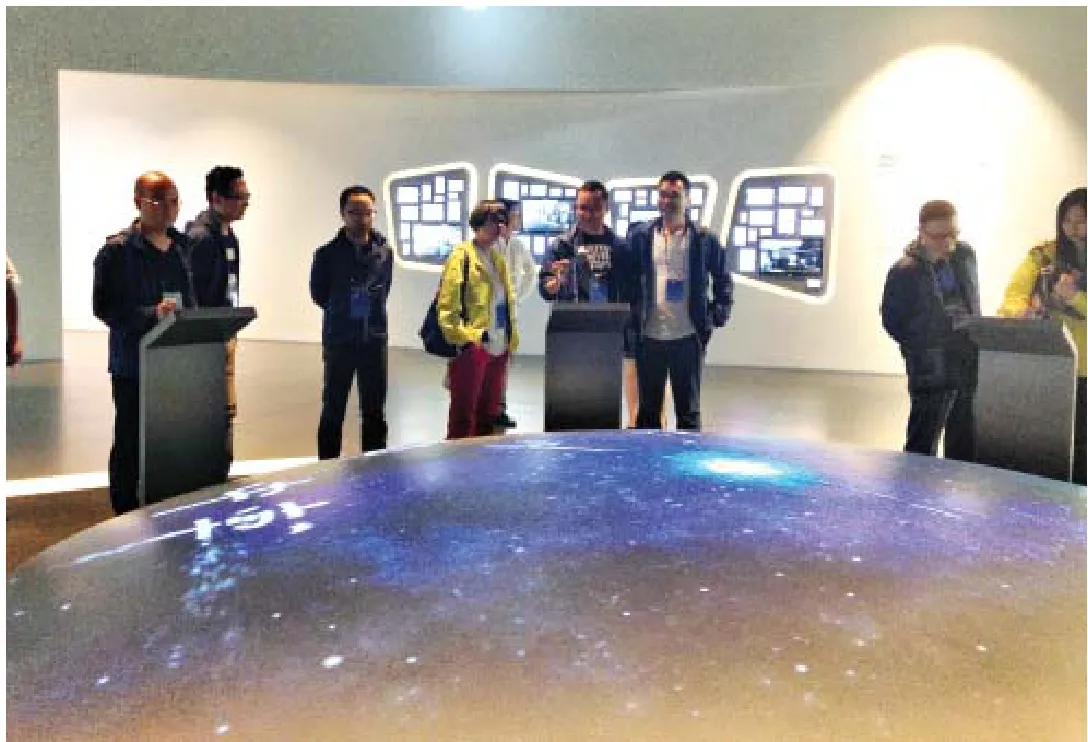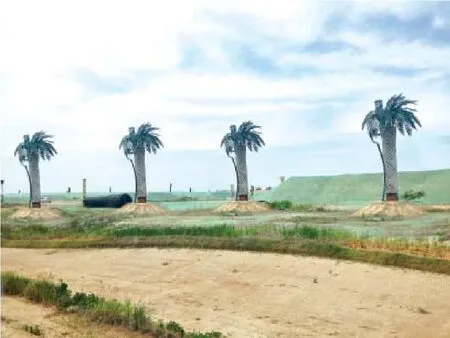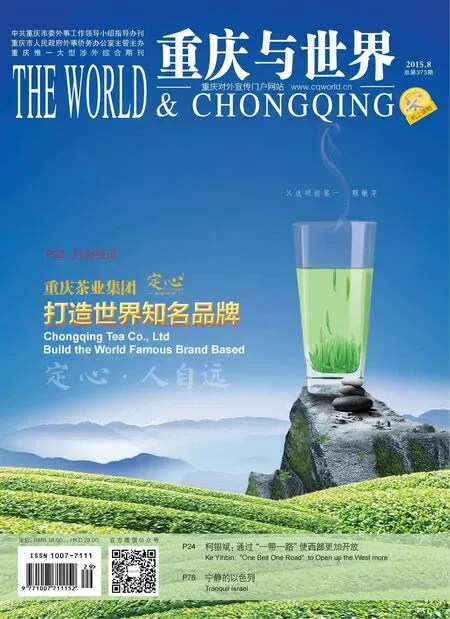体验共鸣之旅 创见美好未来
——随“中国青年友好使者代表团”访韩有感
□文/本刊记者 胡欣
体验共鸣之旅创见美好未来
——随“中国青年友好使者代表团”访韩有感
□文/本刊记者胡欣
2015年6月1日到8日,我有幸成为中国青年友好使者代表团180名团员中的一员,与来自北京、山东、天津、四川等9省市的团员们一道,前往韩国进行了为期8天的参观访问。
中国青年友好使者代表团是韩国国际交流财团主办的两国青年交流活动,已经连续举办七个年头了。此次访问的主题为“迈向创新 共鸣之旅”。在韩访问期间,代表团先后访问了首尔、水原、京畿道、济州岛等地的政府部门和知名企业。团员们对韩国在环境治理、经济技术革新、文化传承推广等方面印象深刻,对韩国也有了更加全面深入、真实的了解。
初夏的韩国,气候宜人,远不同于我们正处于湿热之中的重庆,能够亲身感受依托飞速发展外向型经济诞生的“汉江奇迹”,对于我这样一名重庆涉外宣传工作者无疑是非常难得的机会。离别之际,“朋友一生一起走,那些日子不再有……”周华健温暖的歌声在现场响起,欢送晚宴的大屏幕上正播放着中国青年友好使者代表团团员们访问韩国的精彩照片,八天来的美好行程一幕幕从眼前闪过,在访问中我所到的韩国在创新创造、可持续发展、文化传承等方面的独特内容再一次在我的脑海里面激活。
创新:韩国经济新的增长动力
韩国国土面积狭小,资源极度贫乏,却能取得如此瞩目的经济成就,靠的是什么呢?在三星创新博物馆和庆北创新经济革新中心,我们找到了答案。
三星创新博物馆的展示主题为电子产业的过去、现在与未来,从法拉第、爱迪生、贝尔等人的发明,历代电话、电视的演变,一直到现今的行动设备、智慧家庭等等。博物馆整个场地十分高科技。展览区的介绍萤幕并非传统的平面萤幕,而是以装置艺术的方式,以一个大罩子将观赏者罩住,呈现360度环绕包覆式的观赏体验。各种展示物放置在展示空间墙壁之内,以玻璃墙面与游客隔开,而这些玻璃是可以互动的玻璃,介绍文字内容浮现在玻璃之上,还可以触控看更深一层详细的内容。博物馆汇集了历史上一些电子创新杰作。这些创新为科技奠定了基础,有助于开发和完善产品。
2014年成立的庆北创造经济革新中心是一个由政府倡导、三星企业负责具体运营的创业指导机构。凡是符合中心要求的机构和个人都可以向中心提出申请,中心利用大企业的成熟经验,为创业者提供包括免费使用专利、获得资金支持等各种帮助。有代表团成员认为,韩国创造经济革新中心类似于我们国内的孵化器,但又不完全等同国内孵化器,国内的孵化器缺少有经验、懂市场的大企业参与。创业不能只停留在口号上,实际问题还需要必要的指导和告知,韩国大企业引领的模式值得我们学习和借鉴。

三星创新博物馆
环保:从垃圾堆变身“dream park”
此次中国青年友好使者代表团访问行程中,有一处参观点是韩国首都圈垃圾填埋地。正当我们质疑垃圾堆有什么好看的时候,车子缓缓驶入了填埋现场,颠覆了我们对垃圾填埋臭气熏天、污水横流的固有印象,呈现在眼前的是鸟语花香、绿意盎然的公园,一如它的名字“Dream Park”——梦幻公园。

首都圈垃圾填埋地

水原华城的武艺表演
工作人员介绍,整个填埋地分为四个填埋场,填埋场总面积达到1600万平方米,相当于2800个足球场面积。总填埋量约为22800万吨,预计可使用至2044年。
“猜猜这些树是真的还是假的?”工作人员指着车窗外一排排的“棕榈树”问。原来,这些“棕榈树”的主干是收集沼气用的。过去填埋过程中产生的沼气以点燃的方式处理掉了,现在则是用分布密集的管道进行统一收集,带动起5万千瓦的发电厂,从这里产生的电力供应着京畿道一年约18万人口的生活用电。并且从2007年3月开始投入商业运营。由民间企业为主导建立发电厂,通过一定时期的运营收回投资成本。
填埋地的野生花园过去是煤灰露天堆货场,现在这里有着面积达86万平方米的蒲苇地、菊花花园和自然湿地,开放给公众休憩。第一填埋场于2000年10月结束填埋,修建起了地上体育公园、飞行体育公园、高尔夫球场和一座体育馆。这里还成为了2014年亚运会的赛场之一。
韩国首都圈垃圾填埋地并不是简单填埋垃圾废弃物,而是以绿色理念为指导,对垃圾进行卫生填埋和安全填埋。一度被厌恶的垃圾填埋场,如今华丽变身,昔日的垃圾填埋地成为韩国环境生态人文的乐园,实现人与自然的完美和谐。
传承:重视民族传统和文化教育
当你和韩国人接触的时候,一定能感受到他们强烈的民族自豪感。这种自豪感一方面来自国家经济建设的成功,另一方面则来自对本民族历史和文化的骄傲。
虽然韩国的古迹规模和档次比不上中国。但是他们却万分珍视。在庆州参观韩国著名古迹“石窟庵”,兴致勃勃爬了20分钟山路,到了却发现根本不能近距离观看,因为整个石窟都用玻璃给隔绝了,我们只能透过玻璃向里面望,不能仔细看到什么。虽然有些悻悻然,不过这也足以看出韩国人对古迹保护的慎重。
当然更吸引人的是那些实际表演。比如在水原华城,有传统武艺24技的表演。它是朝鲜传下来的武艺和中国、日本武艺相结合的24种实战武术。它不仅拥有极高的历史意义,在艺术和健身领域也有极高的建树。表演一切都按照古代仪式进行,从服装到武器都相当考究,吸引了不少游客驻足观看。
韩国的博物馆很多,在教育的内容和展馆的布置上,很注重生动形象并让人易于接受,通过动静结合,使用多媒体、现代声、光、电等手段,增强与观众的互动。在韩国前总统朴正熙故居纪念馆里,球幕电影正播放着他的生平事迹。仰卧着的观众被包围其中,屏幕如同苍穹,无论观众选择何种观看视角,均可清晰地观看相应视角的完整景像,伴有立体声环绕,形象生动的再现当时的历史场景,感人至深,我们都看得津津有味。
韩国博物馆、名胜古迹等设施基本对青少年免费开放,我们所到之处都能看到学校组织的学生参观团,更有许多家长带着孩子前来感受体验,接受潜移默化的教育。他们通过观看录像和展品,了解韩国历史,了解韩国现代社会,对待传统文化不仅没有全盘否定,反而将传统文化的优势发扬光大。韩国国民的集团主义、民族主义、爱国精神、艰苦奋斗的品质和团结协作的团队精神,为韩国的经济建设提供了强大的精神动力。
From June 1stto 8th,2015,as a representative of Chongqing’s young civil servants and one of the 180 team members in China Youth Envoy of Friendship Delegation(CYEFD),I paid an 8-day visit to Korea with team members that came from Beijing,Shandong,Tianjin,Sichuan and other fi ve provinces.
CYEFD is sponsored by Korean Foundation for International Communication. It is an activity for young people from the two countries to communicate and this is its seventh year. This year’s topic is “Travelling and Innovation”. During the visit,our delegation went to local governments and enterprises in Seoul,Suwon,Gyeonggi-do and Jeju Island. Team members were impressed by Korea’s environment management,innovation in economy and technology and cultural inheritance,thus having a deeper and more real understanding of Korea.
The early summer in Korea is very lovely,different from the damp and hot weather in Chongqing. It is undoubtedly a great opportunityf for me,a media worker dealing with foreign affairs,to be able to see in person the “Han River Miracle”,which was achieved by developing export-oriented economy. When the trip was about to end,Zhou Huajian’s song Friend was displayed at the ceremony “Friends accompany you all your life,the good old days are gone…”. Some pictures captured during the trip were displayed on the screen. all good memories in the past eight days flashed in front of my eyes,making fresh again what I have seen - Korea’s achievements in innovation,sustainable development and culture inheritance.

Samsung Innovation Museum

Korea’s capital circle landfill site
Innovation: the New Drive to Korea’s Economic Increase
Korea has a small land area and poor resources. What have made it to achieve such great economic accomplishment?We found the answer in Samsung Innovation Museum and Kyungpook Innovative Economy Center.
Samsung Innovation Museum displays the past,present and future of electronic industry. It covers from inventions by Michael,Faraday,Thomas,Edison,Graham and Bell,the evolution of telephones and televisions,to modern mobile devices and smart families. The museum is highly technological. The introduction screen adopts installation art and uses a hood to surround visitors,giving them a 360 degree experience. all the exhibits are displayed behind theinteractive glass walls. Visitors could see introductions of the exhibits from the glass walls and could touch and select for further introduction. The museum gathers some electronic innovations in the history. These innovations laid a foundation for science and technology,and are helpful to the development and improvement of products.
Kyungpook Innovative Economy Center was set up in 2014. This entrepreneurship guidance organization was proposed by government,and was operated by Samsung. anyone or any organization who meets the demands could apply to the center for using mature experience from big companies. The big companies would provide help like allowing to use their patents for free and give the startup capital to support them. Some team members said this center is similar to but not the same as the business incubator in China. China’s incubators lack in experienced and market-minded companies to participate in them. Starting up a business should not be just a saying; it needs necessary guidance and informing. We should learn from Korea’s big companies’ pattern.
Environment Protection: From Garbage Heaps to “Dream Park”
One of the delegation’s visit sites is Korea’s capital circle landfi ll site. Just as we doubted the meaning of visiting landfi ll site,the car drove us into the site. Our impression of bad smell and waste water were overturned by the green garden with the birds’ twittering and the fragrance of fl owers. This park’s name is “Dream Park”.
We were told that there are four landfi lls,covering an area of 16 million square meters,equivalent to 2,800 soccer pitches. The total landfi ll amounts to 228 million tons and is expected to expire in 2044.
“Guess whether the trees are authentic or fake?” The staff asked us on the palms outside the window. The palms’ trunks are used to collect marsh gas. Previous marsh gas coming from burying process has been disposed by burning. Now,dense pipelines are used to collect the marsh gas to put the 50,000kw power station into motion. The power generated here are enough for a year’s use for 180,000 people in Gyeonggido. Starting from March 2007,it was put into commercial operation. Private companies led to set up power stations and they recouped the capital outlay by operation.
The wild garden in the landfill was used to be an open coal ash storage area. Now there are 860,000 square meters of pampas grass,daisy garden and natural wetland for public relaxation. The first landfill was completed in October 2000. Sports park,fl ight sports park,golf course and a gymnasium were built after that. In 2014,it was served as a course for the asian Games.
Korea’s capital circle landfill is not only a landfill of garbage. It is secure landfi ll and green landfi ll with the concept of green principle. The once disgusted landfill now has been transformed into Korea’s ecological garden. It reaches the harmony of people and nature.
Inheritance: Value on National Tradition and Cultural Education
You can definitely feel Korean’s sense of national pride when talking with them. Their pride comes from their country’s success in economy,as well as the pride for their history and culture.
although not as large as China’s historical relics,Koreans value much on the relics. When visiting the Seokguram,we took 20 minutes to climb but when we arrived,we found that it was not allowed to watch at a close distance. all the Seokgurams were protected by glass. We could barely see anything from the glass. although we were a little disappointed,we could see Korean’s serious attitude on the protection of historical relics.
What attracted me more are the culture shows. For example,the Suwon Hwaseong Fortress has traditional martial art show - 24 skills show. It is a set of 24 skills of martial arts combined from the martial arts coming from North Korea,Chinese martial arts and Japanese arts. It has high historical value,artistic value and fitness value. Performances are conducted along the ancient rite. The clothes and weapons were examined closely to put into use and had attracted much attention.
There are many museums in Korea. The content and display were vivid and easy to take in. They use multimedia,modern methods of sound,light and electricity to become interactive. In the museum of former house of Korea Park Chung Hee,former president of Korea,dome fi lm were showing his life story. Visitors lied on their backs and were surrounded by the screen. The screen was like the sky. No matter from which angle of view,visitors could all see the complete image clearly with dimensional sound. We were touched by the history sences.
Most of the museums and historical sites are free to youngsters. We could always see student groups led by their teachers or parents to learn their history and culture. They got to know the history and modern life in Korea via videos and exhibits. They didn’t repudiate their traditional history; instead,they carried the advantages of their traditional culture forward. Their collectivism,nationalism,patriotism,hardworking character and team spirit inject great spiritual drive to Korea’s economy development.
Traveling in Korea and Creating a Bright Future——Impression ofVisiting Korea with CYEFD
□Written by Hu Xin

